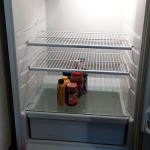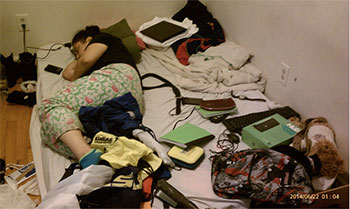Every day people see Melinda Robinson as they stop by Taco Bell to pick up some fast food. But most didn’t know anything about Robinson as a person – until she joined other low-wage workers documenting their lives in a photo exhibit.
Now photos of her life are hanging on the walls of the Talk Shop Gallery, 3936 Main, part of an exhibit called “I, Too, Am America” that opened May 1. The show is a project of the Langston Hughes Club, where fast food workers have been learning picture-taking skills from professional photographer Steve Hebert.
Robinson says with encouragement from Hebert, she and her fellow workers have been learning a new way of storytelling.

Empty: No money, no food by Lindsey Zimmerman. Working for Subway for nearly four years at $7.75 an hour, Lindsey Zimmerman and her husband, Jim, also a fast-food worker, struggle to afford groceries so often rely on food banks and soup kitchens.
“Instead of hearing our stories, people could see our stories. I could tell you a story but if you see the pictures, you get a better understanding. If you see it, you can’t brush it off so easily.”
Robinson, 38, works at the Taco Bell on Blue Ridge Cutoff and has worked in the fast food industry for 22 years. She and her husband have seven children, six of whom live at home. She makes $9 an hour working about 29-32 hours a week. She is one of the founders of the Workers Organizing Committee of Kansas City.
Robinson is part of the growing national movement of workers fighting to be paid $15 an hour and get the right to form a union. In April, the largest rally so far took her and many other workers to the streets with picket signs.
The photos at the exhibit show workers on strike. But they also show a more intimate side of their lives, like a photo of a nearly-empty refrigerator or a worker’s sparse room the day before she got evicted. As she points them out, Robinson says “I’ve been there.”

Eviction by Dallas Winters. “I took this photo the day before we got evicted. Both Cassie and me were working at Church’s Chicken. We were behind a good three months in rent and my mom had just showed us a paper that said we needed to come up with $1100 dollars. I had just got paid but there was no way to pay that. I felt like I was working for free.”
She’s hoping the photos will help convince more people that raising wages and giving low-wage workers sick leave, vacation and other benefits is good for the country. She’s been involved in the Fight for $15 movement since 2012, and she’s been trying to convince other low-wage workers to get involved.
“I’m trying to get people to understand ‘you deserve better.’”
Although Robinson has had some hard times – sleeping in a truck, not having a place she and her family could take a bath, needing medical tests she can’t afford – her photos in the exhibit show happier times. One is a “selfie” of son Mikie.
“My kids are my strength. They keep me going,” Robinson says. “I feel bad as a mother when my kids tell me they are hungry. But when I look at them, everything is ok.”
She also says she believes if workers stick together now, their children will have a better future.
“They won’t have to struggle. They won’t have to worry about which bills to pay or whether there is food in the refrigerator.”
The exhibit will be at the Talk Shop gallery through the end of the month.




Who’s talking